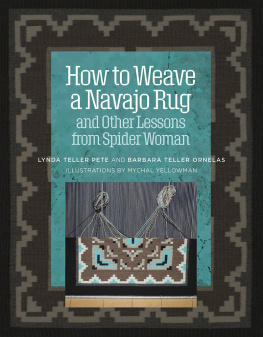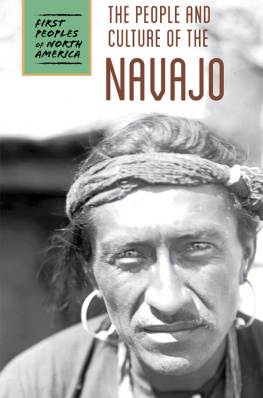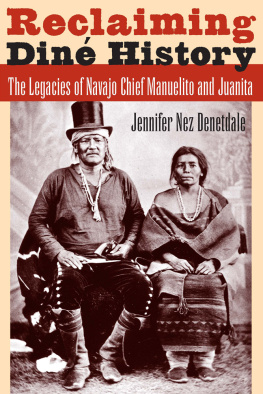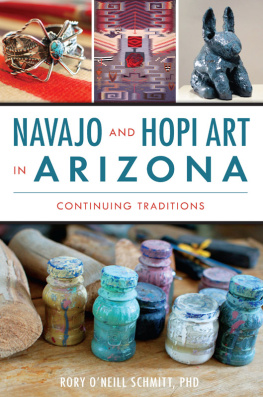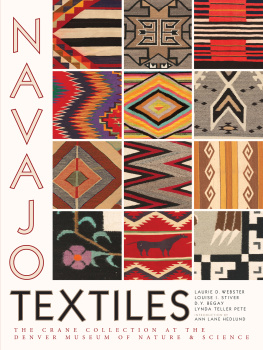2005 by the University Press of Kansas
All rights reserved
An earlier version of Chapter first appeared as The Making of the Navajo Worker: Navajo Households, the Bureau of Indian Affairs and Off Reservation Wage Work, 19481960 , New Mexico Historical Review 74 (October 1999 ): 375405 . Copyright University of New Mexico Board of Regents. All rights reserved.
Portions of Chapter first appeared in Native Pathways: American Indian Culture and Economic Development in the Twentieth Century, edited by Brian Hosmer and Colleen ONeill (Boulder: University Press of Colorado, 2004 ). Copyright University Press of Colorado. All rights reserved.
Simon Ortizs poem, Starting at the Bottom, portions of which appear in chapter 4, was originally published in Woven Stone (Tucson: University of Arizona Press, 1992 ). Copyright Simon Ortiz. All rights reserved. Used by permission.
Published by the University Press of Kansas (Lawrence, Kansas 66045 ), which was organized by the Kansas Board of Regents and is operated and funded by Emporia State University, Fort Hays State University, Kansas State University, Pittsburg State University, the University of Kansas, and Wichita State University
Library of Congress Cataloging-in-Publication Data
O'Neill, Colleen M., 1961
Working the Navajo way : labor and culture in the twentieth century / Colleen O'Neill.
p. cm.
Includes bibliographical references and index.
ISBN 978-0-7006-1395-3 (cloth : alk. paper)
ISBN 978-0-7006-1894-1 (pbk : alk. paper)
ISBN 978-0-7006-2369-3 (ebook)
. Navajo IndiansEmployment.. Navajo IndiansSocial conditions.. Navajo IndiansGovernment relations. I. Title.
e99.n3o64 2005
979.1004'9726dc22
2005011125
British Library Cataloguing-in-Publication Data is available.
Printed in the United States of America
10 9 8 7 6 5 4 3 2 1
The paper used in this publication meets the minimum requirements of the American National Standard for Permanence of Paper for Printed Library Materials Z39.48-1984 .
For James P. and F. Gay ONeill
acknowledgments
I would like to acknowledge the many people who significantly guided the direction of this project. First and foremost, I would like to thank the Navajo people who generously trusted me with their stories. I owe a great deal to Clarence and Margaret Kee and their daughters, Juannita Brown and Annita Fonseca, for sharing their memories with me. I would also like to thank Tsosie Blackgoat, Burton Yazzie, and Joe Lee Watson and Rebecca Tazbah Lee Watson and their son, Earl Lee Watson, for their recollections about living and working in and around the Window Rock coal mine. I am deeply grateful to Lawrence Oliver, who introduced me to those families and on occasion served as a translator. His nuanced insight into the labor and political history of the area helped me to better understand the context of their stories. The few accounts I gathered from these conversations recall an important part of a larger history that the Kees, Watsons, Blackgoats, and Yazzies made. I was honored that Kenneth White, a man who profoundly shaped the course of Navajo labor history, agreed to talk with me. I hope this book approaches his exacting standards and honors his unshakable spirit.
I owe a great debt to the Navajo families living in the Hogback community near the northern edge of the reservation. Special thanks to Harris Cambridge, Helen Duncan, Evelyn John, Betty Harvey, Harry John, Julia John, Tom Jones Jr., Alice Jones, Charlie Jones, and Juanita Jones. I deeply appreciate the considerable help I received in locating miners and their families. In particular I am grateful to Charlie Jones Jr., president of the Hogback Chapter of the Navajo Nation, in allowing me to discuss my project at a chapter meeting. None of these interviews would have been possible without Minnie Hamstreets and Paul Georges good humored and patient translation assistance. When I was in Farmington I decided to look up my husbands old air force buddy, and she turned out to be Ethelinda Corley, a wonderful person whose family had for years offered their insight and translation help to people like me. I truly appreciate Ethelindas hospitality and her continued friendship. Last but not least, I would like to thank Tom Wheeler, the owner of the Hogback Trading Post, for his help and encouragement.
I am thankful to have had the opportunity to interview the late Charles Mattox, who remained a true revolutionary and innovative artist into his late eighties. His memories supplied some of the harder-to-document facts about the 1933 Gallup strike. I also feel very lucky to have met Lavine Bennally White, a Navajo woman who lived a few blocks from me when I lived in Highland Park, New Jersey. Her engaging spirit and generosity continues to inspire my work.
Archivists supplied me with what seemed like life-saving help locating sources and arranging research trips. I would like to thank Kathlene Ferris and Nancy Brown from the Center for Southwest Research at the University of New Mexico. By suggesting that I take a look at the Albuquerque and Cerrillos Coal Company papers, Kathlene changed the course of my original research plan. Allowing me liberal access to that collection, she made the task of sorting through unprocessed papers a plausible undertaking. Nancy Brown tirelessly worked at locating obscure sources. Her diligence and thorough efforts to find materials made me feel that she was as committed to this project as I was. At the New Mexico State Records Center in Santa Fe, Sandra Jaramillo and Al Regensberg were incredibly generous and helpful. Equally accommodating were the staff at the National Archives: Joan Howard from the Rocky Mountain regional branch, Ann Cummings and James Cassedy at Archives II in College Park, Maryland, and Paul Wormser at the Pacific Coast Branch in Laguna Niguel, California. I also appreciate the help I received from Brad Cole, currently head of Special Collections at Utah State University, who during the course of my research helped me locate sources in special collections at the Cline Library at Northern Arizona University. Thanks to Diane Schenk and Denise Conklin at the Labor History Archive at Pattee Library at Penn State, who steered me toward the relevant materials in the United Mine Workers records and arranged affordable accommodations while I was in University Park conducting my research. Christine Marn, Pat Etter, and Edward Oetting at the Hayden Library at Arizona State University, and the curatorial staff at the Historic Hubbell Trading Post, went beyond the call of duty to help me locate relevant materials. Eunice Kahn from the Navajo Nation Museum graciously helped me locate the Milton Snow photos that appear in the book. Thanks to Terry Reynolds, Curator of Collections and Exhibits at the University Museum, New Mexico State University, for her work on Emma Reh and for guiding me to the Red Lake Trading Post records. Last but not least, I am grateful to Roger Myers of the University of Arizona Special Collections for his prompt response to my research questions over the phone.


